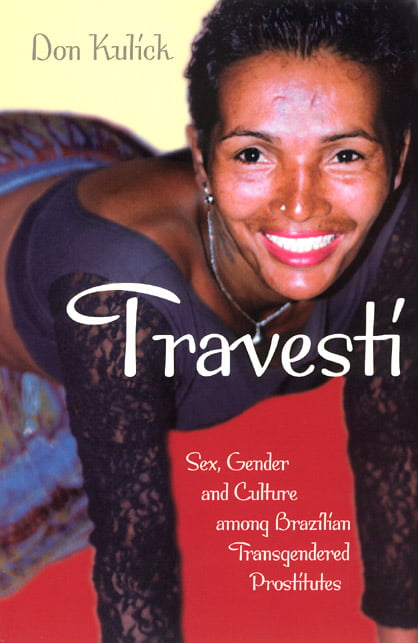Originally posted 2018-09-26 06:30:05.
 On the tenth anniversary of completing the first draft of The Warm Pink Jelly Express Train, I am republishing this article about it. It describes an affair between a Brazilian transsexual prostitute and a Western straight man.
On the tenth anniversary of completing the first draft of The Warm Pink Jelly Express Train, I am republishing this article about it. It describes an affair between a Brazilian transsexual prostitute and a Western straight man.
The Warm Pink Jelly Express Train was a very difficult book to write. Compared to my previous one, Poaching the River, it required profound reflection and much research.
Poaching is essentially a romanticised memoir; The Warm Pink Jelly Express Train is nothing like that. It is far deeper and more introspective and writing it, shaped my current world view.
My ideas about gender in particular were formed by the research and writing of The Warm Pink Jelly Express Train. Although it is a breathlessly-paced romantic adventure, it required me to dig deep into the natures of gender and sexuality, something I had never done before.
Essentially, The Warm Pink Jelly Express Train is about a meeting between Rafy, a beautiful young Brazilian transsexual prostitute, of the type known in Brazil as a travesti, and a recently-divorced British man named Brian. It is written in the form of a fast-paced thriller. Through the story of their encounter, falling in love and the subsequent scandals, I told the story of the lives of dozens of travestis, both in Latin America and in Europe.
Of course, being trans was not the fashion statement then that it has become now and information was hard to find. I spent hours that amounted to months of time on forums where the subject of transgender was discussed, but I did a great deal of conventional research too. There were precious few books and papers available but I read them all.
I learned Spanish (thanks to the lovely Fabi Pinilla, my longsuffering teacher, who became a real and lasting friend) and enough Portuguese to read interviews in those languages. This was because at the time, there were practically no such resources featuring young transgender women in English. But there were and remain, many published in Brazil, Argentina, Chile, Colombia and elsewhere in South America, as well as in Spain itself, where there is a long history of trans cultural integration. The artists Picasso and Dali associated with transwomen, as did the film-makers Luis Bunuel and Pedro Almodovar.

I hired a translator, a Portuguese woman studying at Dundee University and with her help and my Spanish, I managed even to carry out telephone interviews with a number of girls, living in both Europe and in their home countries. I was heavily indebted to Dr Don Kulick’s book ‘Travesti: Sex, Gender, and Culture among Brazilian Transgendered Prostitutes’ which remains the most thorough scientific study of the lives af Brazilian transsexuals.
There appeared to be a dichotomy between the culture in these Latin countries and that in North America and the UK. In the former, nearly all the trans women appeared to have transitioned young, often at or before puberty. They typically began taking feminising hormones around the age of twelve or thirteen and sometimes even before. Both Kulick and I discovered cases of boys who had begun taking hormones by the age of eight and this was confirmed by others around them. This information fed directly into the construction of Rafy, The Warm Pink Jelly Express Train’s female lead; she tells a story typical of Brazilian trans women.
However, in the Anglo-Saxon world, the majority — by far — of trans women then transitioned over the age of forty. This surprising dichotomy was resolved by Dr Ray Blanchard in research carried out between 1980 and 2005.
More information about the current scientific understanding can be found here.


In 2008 I thought that the consequence of the repression they suffered was that transwomen were bottling up their true natures, often for decades; this was why they presented late and, because of this, I was very suspicious of Blanchard’s Typology. I had in fact become seduced by the ‘brain sex’ theory, which Blanchard’s challenges. However, the last six years, which I have spent, cumulatively, over two of in Asia, have completely changed my mind. Blanchard is born out entirely by observation with only detail difference between the Western profiles he discusses and those found in SE Asia.
THIS article describes these forms in depth.
I believe that as repression is reduced we should see many more girls transitioning young and the demographic in the West should align with that which is seen elsewhere, in Asia, for example. This would mean that, relatively speaking, we should see fewer gay males presenting as men and far more transitioning.
Today, of course, that is what we do see and so Rafy’s story is even more relevant to the West than it was ten years ago.
Back in 2008, when I was writing The Warm Pink Jelly Express Train, I was still very much in research. I believed that transwomen were being erased by society, by health professionals and in the media. In some ways Warm Pink was my reaction against society’s attempt to erase the identity of an oppressed group altogether and at the same time an attempt to artistically engage with my own attraction to transwomen. Today, many of these concerns have been assuaged, but there is an increasing risk of a backlash against transition by a group calling themselves ‘gender-critical’. This is an alliance of transphobic feminists and homosexual males who prey on the understandable fears of parents.
The book was an attempt to publicise the fact that not only do young transwomen exist, but they have established, valid, lived histories which are consistent throughout the world. They know they are trans from long before puberty. Their gender dysphoria is such that they simply cannot live as boys. They are almost exclusively attracted to men, and generally prefer the submissive role in sex.
I explored these alternative sexualities through AnnaMaria’s relationship to Rafy — there was never any doubt in my mind that this was a case of unrequited desire — and Rafy’s with her prior mentor, Marina.

Perhaps the most fascinating thing I discovered in researching the book was the extensive support network that exists for young travestis. Brazil is a conundrum: the culture is viciously macho and repressive, yet there are huge numbers of transwomen. Murder rates against them are the highest reported in the world, yet Brazilian transgender beauty is iconic and has been celebrated for decades; witness Roberta Close.

I struggled at first to see how this could be, but it seems that the support network is the key. Young transgirls are adopted by older transwomen and then educated — in being transgender– and supported though their journey of transition, which they fund — certainly in Brazil — almost exclusively by sex work. A similar support system, although not based on prostitution or sex work, exists in the Philippines.
Janet Mock’s excellent Redefining Realness idescribes a very similar support network and how she, too, funded her transition through sex work. I think it shows great courage and integrity that she should be so open about this and I highly recommend her book.
This support network allows young transsexual women to survive in these repressive cultures, which I was able to confirm when I began to visit the Philippines. Here, there is severe prejudice and discrimination against trans people because of the generally malignant influence of Christianity, yet transwomen are everywhere. This is explained at night, when you discover an entire subculture that sustains them.
So The Warm Pink Jelly Express Train is about the nature of young transwomen, of a type which is suppressed in the West. Young trans women’s narratives and lived histories were being suppressed and I wanted to redress that. At the same time, of course, the book is an exploration of my own relationship to transwomen, as a man.

Through Brian, the book’s male lead, I explored the nature of the relationship between a trans woman and a straight man who loves her. I put him in a position he could never have believed he would be in, and let him find his fate. There was no predetermined narrative and the end was by no means a foregone conclusion. It was just the way it worked out.
I gave Brian a real test, to find out what he was made of; and in the end, I think he came through with flying colours.
However, Brian and Rafy’s relationship reveals something else: transwomen feel affirmed by their relationships with men. This is part of the attraction that not only sex work, but also cabaret dancing, modelling, beauty pageants and a range of other activities have for them.

Writing The Warm Pink Jelly Express Train was a voyage of discovery for me, and I tried very hard to be true to that. The second edition, which contains many revisions, reflects discoveries I have made since it was first published, but no substantive areas have been changed. It is currently available both as a print book and an eBook.
https://www.rodfleming.com/books/the-warm-pink-jelly-express-train/






I’m trying to reconcile this essay with your review of TMWWBQ and other essays. You must have had a change of opinion? Blanchard’s typology is fully supported by the science, yet in this essay you describe it as “psuedo-science” and “debunked”?
The difference between the experience in other nations and the Anglo-sphere is one that Anne Lawrence discovered is based on the difference between cultures regarding “individualism” vs. “collectivity”. In the English speaking nations, Autogynephilies dominate (pun intended) and HSTS transkids are treated poorly by them, unless they go out of the their way to be supportive of the AGP narrititive that we are all the same.
Thank you Kay and I must say I appreciate that you took the time to read it! You are right. I have amended the copy to bring it into line with my current position, which is that Blanchard is, at present state of knowledge, correct.
When I wrote Warm Pink it was in the aftermath of Bailey’s defenestration. I actually spoke to him at that tine and read the book, which I found innocuous. However I was then persuaded that the Blanchard position was mistaken. I do not think that now and have changed the post accordingly and added an explanation.
However, I will take issue on Lawrence and Asia. I am afraid she is doing what all too many Western researchers do, and having a quick glance at Asian culture then making up some appropriate, usually culturally-insensitive, colonialist nonsense. I have spent a long time in Asia looking at this and her comments just do not reflect reality there. In addition I would say that the USA is at least as coercive and conformist as Asia; I just have to look at the stories of atheists living there to see that.
Leaving that aside, however, in fact there are AGPs in Asia, they just are…different. In the first place they transition much younger, in their teens often. They may have girlfriends (either TS or natal) or they may be analloerotic, in which case they won’t. Many are bisexual and amongst this group are ‘ladyboy tops’ — often prostitutes who specialise in penetrating men. (This preference is so rare amongst HSTS there that it can be discounted, in all honesty.) They will transition while in their teens and begin taking hormones — which are freely available without prescription — at that time, so they feminise in appearance well. They do not tend to be as feminine as HSTS in manners or comportment, however.
Their numbers are small but they are obvious enough once you know what you are looking for. One survey in Thailand (by Winter) suggested 1:300 of a sample of TS were gynephilic. My exploration suggests it’s higher, maybe considerably so. I think that Western observers are being fooled because AGPs in Asia look so much like HSTS. There doesn’t appear to be the radical age of presentation difference that we see in the West, between HSTS and AGP. I know HSTS who transitioned in their thirties and AGPs who did so at 16. I am pretty sure this is happening because Asian cultures, at least in Thailand and the Philippines, which are the ones I am most familiar with, are partial matriarchies (so misogyny, while present, is different) and also, while TS do suffer discrimination, they are obvious and everywhere. (Many Westerners just don’t see them. It amazes me.)
I think the overall numbers of transitions of both types are determined by the social conditions. The Asian model suggests that AGPs there tend not to wait until they are older to transition, because they simply fit into the general milieu of obvious transgenders, who are everywhere. Remember that AGPs are often attracted to HSTS and the presence of ‘out’ HSTS in large(I do mean large) numbers may not only be providing encouragement to transition early but a pool of potential sexual targets.
Bailey and Lawrence both argue that AGP may be innate — so it should occur at about the same rate in all human societies. I would argue that AGP is pretty much as prevalent in Asia as it is in the West, but it is masked by the far greater numbers of apparent HSTS; so the question is not ‘what’s different abut Asia’ but ‘what’s different about the West, especially the US’. In my opinion this is the rampant levels of misogyny and homophobia in the West. Far from being ‘free’, Anglo-Saxon culture uses violence and social exclusion to coerce individuals to fit within accepted group identities.
Because of that social pressure, misogyny and ‘femiphobia’, many HSTS who would transition in Asia, in the West live as gay ‘men’ (Zucker and his ilk made careers out of this.) What seems to happen is that while in Asia, feminine androphilic males see a natural route to transition, with a very large support group and many do, in the West, cultural misogyny, assisted by ‘femiphobia’ amongst gay males, prevents this and they have to pretend to be men instead.
So the apparent numbers of HSTS vary widely from culture to culture, depending on social pressures. At the same time, while lessened misogyny and femiphobia may encourage AGPs to transition much earlier than they would in the West, the total numbers remain small — probably not much different from the West, pointing to a common baseline prevalence and tending to confirm the suggestion that AGP is innate. So it is a lot more complex than just ‘individuals are more free in the West’, which they are not, in any case.
Your comments about abuse of Western HSTS by AGPs I concur with completely. You may be amused to know that recently I was discussing this and was messaged by a Filipino AGP who complained that it was AGPs who are ‘being erased’ by HSTS. — Well they’re not really being ‘erased’ so much as vastly outnumbered.
Rod,
Thanks for the explanation. But I am very curious about how your change opinion came about. The reason I ask is it could help inform my own writing, allow me to be more persausive. An essay on the topic would be great.
Other items in your response… in the US, we too have a small number of AGPs who transition young, always have. It was one of the things that caused me trouble when I was a teenager… Oh… and like Asia, the US has always had a network of HSTS who help each other. “Jenny June”, in her second book, written around 1920, spoke of it existing in New York City back then. In a way, I’m an odd ball… I was living full time as a girl, age 18, for months, on my own before meeting ANY transfolk… and when I did meet some for the first time, it was at the Stanford Clinic, in a room of perhaps 40 AGPs! There were no other HSTS. The clinic essentially said, “Here are your peers.” Me? I was thinking, “If these are transwomen… WTF am I?” A few weeks later, I got connected with HSTS my own age, none of whom were connected to the Clinic… cause, no money. It was a different world, night and day. You mentioned it in another one of your essays, compare two young transfolk, AGP and HSTS… and the difference is startling… yes, the young AGPs can pass better… but OMG, the difference in behavior.
I AM amused to hear of an AGP complaing about being erased… largely because most AGPs would LOVE to be “erased”, thought to be in essence, HSTS. In the States (I grew up and currently live in California.), the AGPs actively work to erase the distinction, constantly telling folks that “gender” and “sexual orienation” are completely separate from one another. (NO, they are NOT!) I wrote about this in one of my essays (posted at Transkids.us) Kiira Trea once speculated that the two types can’t coexist in a society… that one will push the other into the background.
BTW, I too travel to Asia, but I travel for work to Korea, Japan, and Taiwan. I expect that my career will also take me, eventually, to China. But, because I am “stealth” in my career (“Kay” is not my legal name… but one that I used when I was living on the street as a late teen/early 20s)… I never tried to make contact with the HSTS in those countries. Besides… I’m too old to go clubbing! I turn 59 in just a few days. Yep, I’m now that “older” transsexual helping the youngsters!
So much more to write about… but this post is already too long…
Best…
Hi again Kay,
Well, I turned 60 in March so I know how you feel.
Really what made me re-examine my position was spending so much time in the Philippines. The continuum between feminine gay ‘men’ and trans women is just undeniable. So Blanchard got full check marks there. In fact I had always kind of seen that part of the typology as being valid, it is very intuitive. In a way I think the ‘AGP’ part is very counter-intuitive indeed and I really suspect that many people instinctively feel it must be flawed. So what happens is that the ‘brain sex’ theory, which has great plausibility, replaces that part, and then, as you say, it gets conflated into one big bouncy ‘we’re all the same really’ kind of thing.
Now for a long time I didn’t read too much in this area, but last year, for a number of reasons I began to again. I guess maybe 7 years had elapsed in the meantime, and during that period a good deal of new work had been done. My ‘Eureka’ moment was when I discovered the MRI testing by Savic and Arver, and by Rametti et al, done in 2011. Up till then the neurology had basically been from Zhou in 1996 and although this had been methodologically questioned, it had not been either properly debunked or repeated. Well the 2011 work really did change things for me. As I’m sure you know, Rametti found that HSTS brains were similar to women’s’ and Savic and Arver that AGP brains were indistinguishable from men’s. That made me remember something said by Blanchard in an interview I’d read, saying that when it was possible to test, we would find exactly this difference. (Bailey said something similar I think.) So here was a specific prediction now confirmed, and what a prediction: if that holds up, then the whole Typology does. So I had been dead wrong.
That made me go back and look again, very hard. The more, this time, that I read Blanchard and the surrounding literature, as well as Winter, the more obvious it became that Blanchard was describing exactly what I could see in Asia, except it was different in appearance. For a good while I thought that AGP didn’t exist there, however, and so thought it might have been a cultural thing. Then I began to meet some Asian AGPs. The only thing that conflicts with Blanchard is the age. But as you say, there are young AGPs in the West and of course the Cotton Ceiling fiasco comes to mind at once.
I am now fairly sure that a significant number of the transwomen who work as pageant queens and cabaret girls in Asia are actually AGP, and extremely feminine with it, so again, there are some conflicts with the Western model. (I can also think of quite a few HSTS who are not very feminine at all, mark you.) Interestingly, it seems that some AGPs form relationships with transmen — not a generalisation, but some. (HSTS never do; they have a specific interest that transmen cannot deliver.) I suspect that where these particular transwomen do form relationships with men they are bisexual, in the Blanchard model, but I think their primary sexual motivation is the pageant or cabaret participation itself. But I do know AGPs who have girlfriends there too, and who do not work in pageants.
I think where I am now is that, as regards AGPs in Asia vs the Anglo-Saxon West, there are really pronounced differences in the social and personal profiles, but the underlying aetiologies match, so Blanchard nailed it.
In the future I am going to look at the pageant scene much more closely; it’s very important and I think it will reveal quite a lot.
The trans support network in Asia and especially the Phils is awesome. Did you know that there is a TS language in the Phils? They all speak it and it is not just a dialect — they actually have to learn it. It’s called ‘Bekimon’ and it is so strange to hear — and quite obviously incomprehensible to other Filipinos. Any subculture that actually has its own language is highly developed and successful.
BTW, a curious thing is that I used to contribute on Quora and as long as I was parroting the ‘brain sex’ theory I was fine; as soon as I began proposing Blanchard I was banned from posting or editing. At least I don’t think it was my comments about the sound of Spitfire engines! I think that says a lot about Quora.
Also you are right about gender and sexual orientation being intimately related. Two sides of one coin, I’d say.
PS I am busy going through the old posts and repairing them ahahah
Best to you too
Hi again
I will work that response up into an essay, it’s a good idea. Thanks